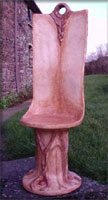Time to test all that hard work. Turn your pedestal throne/chair upright. If it’s still standing, which it should be, make a very thick pulp. Now, cover the whole piece top to bottom as if icing a cake. The layer of pulp should not be thick or the moisture from it will penetrate the integrity of the structure. Follow this procedure several times allowing each layer to totally dry first. By adding this extra pulp, not only will you have made your piece stronger, but you will have also given yourself a smooth even surface. At this point you can, if you choose, apply linseed oil, but to be honest I never do this as it is not needed.

- Covering
My favourite part! You now have a blank canvas to stamp your own design on. I like to sometimes carve into the pulp or build it up into shapes as I did with this one. To finish, I personally like to stain my pieces rather than paint block colours, but this is a matter of individual taste. Staining tends to give a piece an aged look, and by adding hints of colour here and there adds to the worn image, making it appear very old. Once you’ve finished painting your piece, give it a day before you varnish. This, I find, allows any moisture that may have penetrated the piece (from choice of paints etc.) time to totally dry. It is a real mistake to rush this by possibly sealing any moisture in. I use a clear waterproof exterior varnish and give the piece several coats.

- A blank canvas
Finished Pedestal Throne!
These high back pedestal throne/chairs, when made in pairs, are wonderful for the end of dining tables. I have had a few commissions from eco-conscious customers who believe in recycling, for just this reason.
Post treatment and outdoor use:
This Throne has been left outside on many occasions and has withstood most types of weather, but if you are looking to create a piece for outside use, remember like any wood sculpture or garden furniture it will need upkeep. Papier mache, like wood, absorbs moisture which can damage and weaken the structure, causing cracking.
Ships need upkeep too, even though they are built to sit in water for long periods of time. So, treat your pieces from time to time when needed with an appropriate varnish as you would wooden furniture, or your boat. This is also a good idea for the protection of pieces intended for indoor use against knocks and chipping, although the need will be much less often. You’ve put a lot of time, energy, skill and imagination into your work, so help it stay around for a long, long time.
Final words
I hope that these instructions have been informative in the construction of papier mache techniques for functional eco-friendly furniture. If I can assist you further, please or visit my website: http://mischiefsmuse.fateback.com/Mischiefs_Gall/



